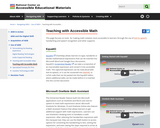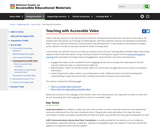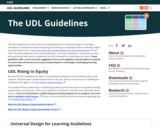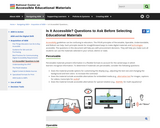
Information on tools for making math notation more accesible to learners.
- Subject:
- Education
- Educational Technology
- Material Type:
- Module
- Provider:
- CAST
- Author:
- National AEM Center at CAST
- Date Added:
- 07/22/2020

Information on tools for making math notation more accesible to learners.

Resources to help educators enhance and enrich their teaching with accessible videos that include captions and/or audio description.

The UDL Guidelines are a tool used in the implementation of Universal Design for Learning, a framework to improve and optimize teaching and learning for all people based on scientific insights into how humans learn. Learn more about the Universal Design for Learning framework from CAST. The UDL Guidelines can be used by educators, curriculum developers, researchers, parents, and anyone else who wants to implement the UDL framework in a learning environment. These guidelines offer a set of concrete suggestions that can be applied to any discipline or domain to ensure that all learners can access and participate in meaningful, challenging learning opportunities.

A set of questions that can be used to evaluate the accessibility of materials considered for procurement.

Sarah Statham, MEd Transition Network Facilitator (TNF) Multnomah, Washington, Columbia & Clatsop counties | Lon Thornberg, MEd Transition Network Facilitator (TNF) Eastern Oregon with InterMountain ESD |The Transition IEP contains post-secondary goals in education, training, employment, and independent living. This session will share universal tech tools for transition that support and accommodate transition age students on the journey to reaching their post-secondary goals. This session will also highlight collaborative and coordinated relationships between students, educators, specialist’s and outside agencies that can be enhanced by the understanding of student’s use and past history with AEM & AT. Use of tools and AEM strategies to access transition activities and resources will be shared.

Session #1 of 8 AEM Across the Lifespan with OTAP - An Accessible Educational Materials Virtual Mini-Conference (recorded 12.07.23)Presented by Debra FitzgibbonsSession Description: Inclusion of all learners in all Early Childhood environments begins by ensuring equal access to learning activities for all children. Timely provision of accessible options ensures learners with disabilities can access the same information, engage in meaningful participation, and enjoy the same services as non-disabled students, with equivalent ease of use. This session will review common vocabulary, reference relevant state and national legislation related to AEM in the early years and connect the dots by sharing examples of Assistive Technology and Accessible Educational Materials in Early Childhood Environments. It is never too early to help learners explore and discover what works for them.

AEM for Inclusion session #2 with Jennifer SouthSession Description: This AEM session will review the meaning of accessibility, and look at why standard formats can create barriers for certain learners. In contrast, we will outline and explore the basic accessible formats. Ideally, educators would provide materials that their students can access, but when that doesn’t happen, learners need a solution. Additionally, some accessible formats may require the use of an assistive technology tool to allow the student to fully interact with the materials being presented. This session will focus on free or low-cost accessible technology tools available on a variety of devices and platforms. Having the right tool for the task can mean the difference in a student’s meaningful and successful participation in their education!

AEM Across the Lifespan session #6 | Gayl Bowser, M.Ed.Independent Consultant | Session Description: When students with disabilities are provided with print based educational materials in accessible formats, their ability to succeed in inclusive educational settings increases significantly. One-to-one technology options for students have resulted in environments where most of the needed resources to provide AEM are available. Yet without administrative support and agency guidelines, it is unlikely that Oregon’s classrooms will be able to provide the accessible learning environments that are mandated by federal and state laws. This presentation will discuss specific roles and actions that school administrators can take to ensure accessible learning environments for students who need accessible educational materials.

AEM Across the Lifespan session #3Michelle Soriano, M.Ed. | Technical Assistance Specialist | National Center on Accessible Educational MaterialsKelli Suding, M.Ed. | Technical Assistance Specialist | National Center on Accessible Educational MaterialsSession Description: Are you looking for a systematic way to ensure that all students have access to high-quality accessible educational materials (AEM) that meet their individual needs? Do you want to learn how to apply the four-step AEM decision-making process from the National AEM Center in your state or district? If so, join us for this interactive session where we will share practical tools and strategies to help you make effective AEM decisions.By the end of this session, you will have a clear understanding of the four-step AEM decision-making process and how to use it to improve outcomes for students with disabilities.Learning Objectives:- Identify the need for AEM and related services- Select and acquire appropriate AEM and related services- Understand how AEM and AT work together- Monitor and evaluate the effectiveness of AEM and related services

Georgeann HartyLow Incidence Disabilities SpecialistOregon Department of EducationOffice of Enhancing Student Opportunities | Debra FitzgibbonsCoordinator, Oregon Technology Access Programand Regional and Statewide Services for Students with Orthopedic ImpairmentDouglas ESD | Session Description: This introductory AEM session builds a foundation for understanding the meaning of Accessible Educational Materials and how they support inclusion of all learners, across the lifespan.Timely provision of AEM, Accessible Educational Materials ensures learners with disabilities can get the same information, engage in meaningful participation, and enjoy the same services as non-disabled students, with the same ease of use. This session will establish common vocabulary, discuss the POUR Principles and reference relevant state and national legislation that pertains to AEM.It is never too early to help learners explore and discover what works for them. They will grow to advocate for these tools that lead to independence. When we make these choices available to all learners, no one stands out. Intentional planning, conversations and collaborations ensure we ask ourselves “Who am I leaving out?”